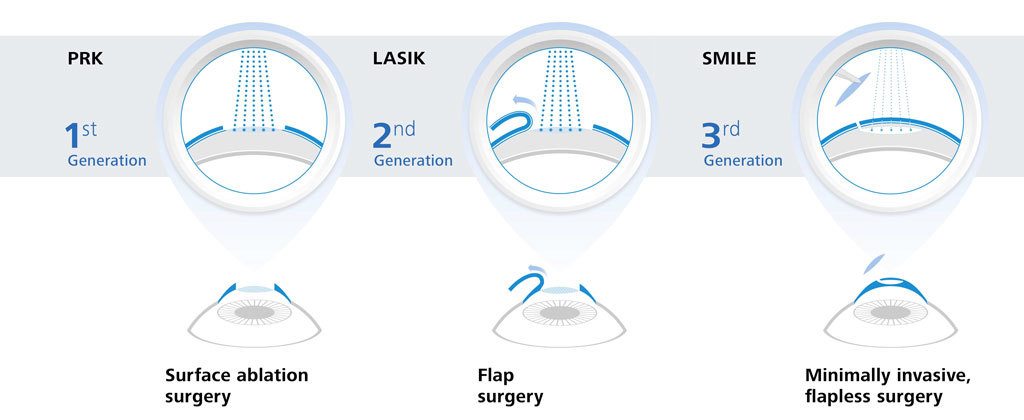What Are The Differences And Similarities Between SMILE Eye Surgical Procedure And LASIK And PRK?
What Are The Differences And Similarities Between SMILE Eye Surgical Procedure And LASIK And PRK?
Blog Article
Published By-Humphries Wilder
If you've been considering SMILE eye surgery, you might question just how it stacks up against LASIK and PRK. Each procedure has its own set of benefits and factors to consider. From quicker healing times to possible threats, there are vital distinctions you need to recognize before deciding. Comprehending these differences will certainly help you make an informed option that aligns with your specific needs and assumptions. Curious to know even more concerning exactly how these treatments contrast thoroughly? Go on checking out to acquire an extensive understanding of SMILE, LASIK, and PRK.
SMILE Eye Surgery Introduction
If you're considering SMILE eye surgery, you'll discover it to be a minimally invasive procedure with a quick recovery time. During SMILE (Tiny Cut Lenticule Removal), a laser is used to develop a small, specific incision in the cornea to remove a tiny item of cells, reshaping it to fix your vision. This differs from LASIK, where a flap is developed, and PRK, where the external layer of the cornea is completely gotten rid of.
One of the crucial benefits of SMILE is its minimally intrusive nature, resulting in a faster recovery procedure and much less pain post-surgery. The recuperation time for SMILE is relatively quick, with numerous people experiencing enhanced vision within a day or more. This makes it a prominent option for those looking for a convenient and effective vision modification treatment. Furthermore, https://www.stuff.co.nz/life-style/123081678/covid19-foggy-glasses-spawn-lasik-surgery-revival-in-the-us has actually been revealed to have a lower threat of dry eye disorder contrasted to LASIK, making it a positive choice for people worried concerning this potential side effect.
Differences Between SMILE, LASIK, and PRK
When contrasting SMILE, LASIK, and PRK eye surgical treatments, it is essential to comprehend the unique strategies utilized in each procedure for vision adjustment.
SMILE (Little Incision Lenticule Extraction) is a minimally intrusive treatment that entails creating a small cut to remove a lenticule from the cornea, improving it to fix vision.
LASIK (Laser-Assisted Sitting Keratomileusis) includes developing a slim flap on the cornea, using a laser to improve the underlying cells, and after that repositioning the flap.
PRK (Photorefractive Keratectomy) removes the external layer of the cornea before improving the cells with a laser.
The major difference hinges on the way the cornea is accessed and treated. SMILE is flapless, making it a great alternative for people with slim corneas or those involved in call sports. LASIK uses rapid aesthetic recuperation as a result of the flap development, but it may present a greater danger of flap-related complications. PRK, although having a much longer recovery period, avoids flap-related concerns entirely.
Comprehending these variances is important in selecting one of the most ideal treatment for your vision correction needs.
Pros and Cons Contrast
To examine the benefits and disadvantages of SMILE, LASIK, and PRK eye surgical treatments, it's necessary to consider the certain advantages and prospective restrictions of each treatment. SMILE surgical procedure uses the advantage of a minimally intrusive treatment, with a smaller incision and possibly quicker healing time contrasted to LASIK and PRK. It likewise reduces the danger of completely dry eye post-surgery, a common side effect of LASIK. However, SMILE may have constraints in dealing with higher degrees of nearsightedness or astigmatism compared to LASIK.
LASIK surgical treatment supplies fast visual healing and marginal discomfort during the procedure. It's highly efficient in dealing with a large range of refractive errors, including nearsightedness, hyperopia, and astigmatism. Yet, LASIK brings a risk of flap difficulties, which can affect the corneal structure.
PRK eye surgery, while not as preferred as LASIK, avoids developing a corneal flap, minimizing the threat of flap-related complications. It appropriates for individuals with thin corneas or uneven corneal surfaces. Nonetheless, PRK has a much longer recuperation time and may include extra discomfort throughout the healing procedure.
Conclusion
So, when it comes to choosing between SMILE, LASIK, and PRK, consider it like selecting the ideal pair of shoes. How Much Does LASIK resembles a smooth, comfortable set of tennis shoes - quick and easy.
LASIK is much more like trendy high heels - flashy and fast, however with some prospective dangers.
PRK is like sturdy hiking boots - reputable and resilient, yet calling for a bit more time and effort.
Inevitably, linked here relies on your specific requirements and choices.
